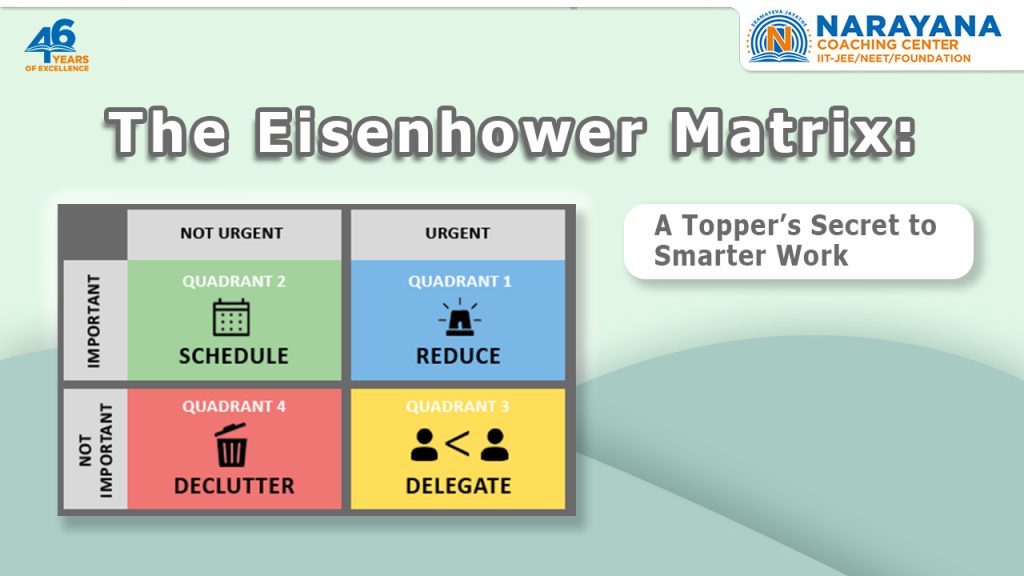
Every JEE or NEET aspirant has the same 24 hours in a day, yet toppers consistently achieve more with less stress. Their secret isn’t intelligence alone—it’s smart prioritisation. One of the most powerful tools they use is the Eisenhower Matrix, a simple yet highly effective framework to decide what’s truly important and what can wait.
In this blog, we’ll explore how toppers apply the Eisenhower Matrix in their daily study schedules, how you can adopt it in your preparation, and why mastering this skill could be the difference between an average score and a top rank.
What Is the Eisenhower Matrix?
The Eisenhower Matrix, also known as the Urgent-Important Matrix, was popularised by former U.S. President Dwight D. Eisenhower. It categorises tasks into four quadrants based on urgency and importance:
- Urgent & Important (Do Now)
- Important but Not Urgent (Plan)
- Urgent but Not Important (Delegate/Reduce)
- Neither Urgent nor Important (Eliminate)
For JEE and NEET students, this framework is a game-changer. It helps prevent wasted hours on low-value tasks and ensures maximum focus on activities that truly boost exam performance.
Quadrant 1: Urgent & Important – Do It Now
These are tasks that directly impact your exam readiness and cannot be postponed.
Examples for JEE/NEET students:
- Revising weak topics before a weekly test
- Solving pending doubts before they pile up
- Making last-minute corrections in mock test answers
- Meeting deadlines for school/tuition assignments
Toppers’ Approach:
Toppers rarely allow tasks to reach this stage, but when they do, they act immediately rather than procrastinating. This habit ensures they never face overwhelming backlogs.
Quadrant 2: Important but Not Urgent – Plan It
This is where toppers spend most of their time. These tasks contribute significantly to long-term success but don’t require immediate action.
- Examples for JEE/NEET students:
- Daily study using NCERT and reference books
- Regular problem-solving practice
- Analysing mock test and logging errors
Building conceptual clarity in physics, chemistry, and biology
Toppers’ Approach:
Toppers schedule these tasks in advance. For instance, a NEET topper might dedicate mornings to biology diagrams and evenings to chemistry problem sets. This consistency helps them avoid last-minute cramming and strengthens their fundamentals.
Quadrant 3: Urgent but Not Important – Reduce It
These tasks feel urgent but add little value to your preparation.
Examples for JEE/NEET students:
- Responding to unnecessary WhatsApp group queries
- Attending every coaching seminar, even if irrelevant
- Constantly checking notifications for updates
Toppers’ Approach:
Instead of cutting them out completely, toppers minimise the time spent here. For example, they check updates once a day instead of every hour.
Quadrant 4: Neither Urgent nor Important – Eliminate It
These are distractions that drain time and energy.
Examples for JEE/NEET students:
- Endless scrolling on Instagram or YouTube Shorts
- Over-discussing paper difficulty with peers
- Watching “study aesthetic” reels instead of actually studying
Toppers’ Approach:
Toppers consciously eliminate these habits. They use tools like app blockers or set fixed “entertainment windows” to prevent distractions from derailing their preparation.
How Toppers Use the Eisenhower Matrix Daily
Here’s a sample application of the Eisenhower Matrix for a NEET aspirant:
| Quadrant | Tasks for the Day |
| Urgent & Important | Complete physics assignment due tomorrow; revise wrong biology MCQs |
| Important but Not Urgent | Study organic chemistry reactions; practise physics numericals; read NCERT biology Chapter 6 |
| Urgent but Not Important | Respond to coaching centre announcements; check exam notifications |
| Neither Urgent nor Important | Browse social media; participate in unnecessary group chats |
Toppers review their tasks every night and plan the next day accordingly. This habit ensures they wake up with clarity, focus, and direction.
Benefits of the Eisenhower Matrix for JEE & NEET Preparation
- Reduces Stress: You focus on what truly matters, so you don’t feel overwhelmed.
- Boosts Productivity: Less time is wasted on distractions, allowing more focus on scoring topics.
- Improves Consistency: Regularly planned tasks promote steady progress.
- Enhances Decision-Making: You always know exactly what to do and when to do it.
Tips to Implement the Eisenhower Matrix Effectively
- Write down your tasks daily and assign them to the appropriate quadrants.
- Limit Quadrant 3 and 4 activities to less than 10% of your day.
- Block dedicated study hours for Quadrant 2 tasks like NCERT reading and mock analysis.
- Use digital planners or sticky notes to visualise your matrix and stay accountable.
Conclusion: Start Prioritising Like a Topper
The Eisenhower Matrix is not just a productivity tool—it’s a mindset shift. JEE and NEET toppers succeed not because they study around the clock but because they study smart. By focusing on tasks that truly matter, minimising distractions, and planning ahead, you too can maximise your preparation.
So, take a notebook, draw your own Eisenhower Matrix, and plan your day like a topper would. Success in JEE and NEET isn’t about doing everything—it’s about doing the right things first.
FAQs on the Eisenhower Matrix for JEE & NEET
Q1. Can the Eisenhower Matrix really help in competitive exam prep?
Yes! It helps you prioritise important study tasks over distractions, ensuring efficient use of time.
Q2. How much time should I spend in Quadrant 2 daily?
Ideally, 60–70% of your study time should be dedicated to Quadrant 2 activities like concept building and practice.
Q3. What if most of my tasks fall under Quadrant 1?
That’s a sign of poor planning. Shift more tasks to Quadrant 2 by preparing in advance.
Q4. How can I deal with distractions in Quadrant 4?
Use apps like Forest or Focus To-Do, or simply keep your phone in another room while studying.
Q5. Do toppers follow this matrix strictly?
Not always perfectly, but they consciously avoid spending time in Quadrants 3 and 4.
Q6. Can I use the matrix separately for each subject?
Yes. You can create individual matrices for physics, chemistry, and biology or maths to manage topics better.
